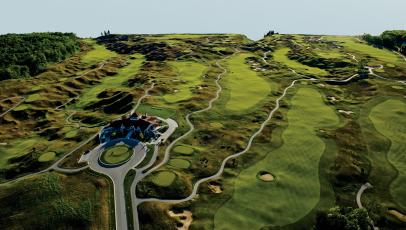Courses
America's best courses on the water, ranked
As you drive north on I-95 and cross the border into Maine, a sign welcomes you and reads “The way life should be.” A golfer playing a course on the water—where holes blend with the coast to create both strategic and aesthetic beauty—may feel a similar sentiment: “The way golf should be.”
Our fascination with courses on the water is near universal. We've determined this list of America's best courses on the water based on panelists’ scores from our most recent 100 Greatest and Second 100 Greatest rankings. Of course, there is a hint of subjectivity involved; what qualifies as “on the water?” Do courses that play along lakes, harbors or sounds count?
We settled on a two-part litmus test. First, the body of water must be substantial—oceans, large lakes, harbors or coastal estuaries count. A small river or stream doesn’t pass this test. Second, the water must be in play, meaning a poor shot is likely to find the trouble at some point during the round. With this litmus test, we achieve our goal: Identifying our nation’s best courses that combine the unique strategy and aesthetics of playing on the water.
Scroll on to see our complete ranking and be sure to expand each course page to read reviews from our course-ranking panelists. We hope you enjoy our searchable course database, Places to Play, our new hub of courses content, complete with course reviews, experts’ opinions and star ratings.
1. Cypress Point Club

From Golf Digest Architecture Editor emeritus Ron Whitten: Cypress Point, the sublime Monterey Peninsula work of sandbox sculpture, whittled Cypress and chiseled coastline, has become Exhibit A in the argument that classic architecture has been rendered ineffectual by modern technology. I'm not buying that argument. Those who think teeny old Cypress Point is defenseless miss the point of Alister MacKenzie’s marvelous design. MacKenzie relished the idea that Cypress Point would offer all sorts of ways to play every hole. That philosophy still thrives, particularly in the past decade, after the faithful restoration of MacKenzie’s original bunkers by veteran course superintendent Jeff Markow.
Read our architecture editor's complete review
2. Pebble Beach Golf Links

3. Fishers Island Club

4. Pacific Dunes

5. Whistling Straits: Straits

6. The Ocean Course at Kiawah Island

7. Bandon Dunes

8. Sebonack Golf Club

9. Monterey Peninsula Country Club: Shore

10. Maidstone Club: West

11. The Kittansett Club

12. Monterey Peninsula Country Club: Dunes

13. Arcadia Bluffs Golf Club: Bluffs

14. Sheep Ranch

15. Eastward Ho!

16. Chambers Bay Golf Course

17. Manele Golf Course

18. The Creek

19. Mauna Kea Golf Course

20. Kiawah Island Club: Cassique

21. Bayonne Golf Club

22. Ocean Forest Golf Club

23. Secession Golf Club

24. Sea Island: Seaside

25. Torrey Pines: South
 - Jon Cavalier.jpeg.rend.hgtvcom.406.229.suffix/1573163040843.jpeg)
26. Country Club of Fairfield

27. Kohanaiki

28. Hyannisport Club

29. Bay Harbor Golf Club

30. The Misquamicut Club





